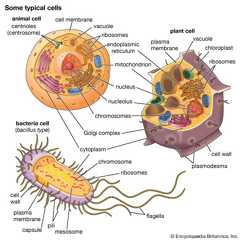chloroplast
Our editors will review what you’ve submitted and determine whether to revise the article.
- National Center for Biotechnology Information - PubMed Central - Evolution and Function of the Chloroplast. Current Investigations and Perspectives
- Florida State University - Molecular Expressions - Chloroplasts
- Frontiers - Frontiers in Plant Science - Editorial: Structure and Function of Chloroplasts
- Cell Press - Plant Communications - Chloroplast gene expression: Recent advances and perspectives
- Biology LibreTexts - Chloroplast
- Khan Academy - Mitochondria and chloroplasts
- BMC - Genome Biology - Chloroplast genomes: diversity, evolution, and applications in genetic engineering
What is a chloroplast?
A chloroplast is anorganelle within the cells of plants and certainalgae that is the site of photosynthesis, which is the process by which energy from theSun is converted into chemical energy for growth. A chloroplast is a type of plastid (a saclike organelle with a double membrane) that contains chlorophyll to absorb light energy.
Where are chloroplasts found?
Chloroplasts are present in the cells of all green tissues ofplants andalgae. Chloroplasts are also found in photosynthetic tissues that do not appear green, such as the brown blades ofgiant kelp or the red leaves of certain plants. In plants, chloroplasts are concentrated particularly in theparenchyma cells of the leaf mesophyll (the internal cell layers of aleaf).
Why are chloroplasts green?
Chloroplasts are green because they contain the pigmentchlorophyll, which is vital forphotosynthesis. Chlorophyll occurs in several distinct forms. Chlorophylls a and b are the major pigments found in higher plants and green algae.
Do chloroplasts have DNA?
Unlike most otherorganelles, chloroplasts andmitochondria have small circularchromosomes known as extranuclear DNA. Chloroplast DNA containsgenes that are involved with aspects of photosynthesis and other chloroplast activities. It is thought that both chloroplasts and mitochondria are descended from free-livingcyanobacteria, which could explain why they possessDNA that is distinct from the rest of the cell.
chloroplast, structure within thecells ofplants andgreen algae that is the site ofphotosynthesis, the process by which lightenergy isconverted tochemical energy, resulting in the production ofoxygen and energy-richorganic compounds. Photosyntheticcyanobacteria are free-living close relatives of chloroplasts; endosymbiotic theory posits that chloroplasts andmitochondria (energy-producing organelles ineukaryotic cells) are descended from such organisms.
Characteristics of chloroplasts
Chloroplasts are a type of plastid—a round, oval, or disk-shaped body that is involved in the synthesis and storage of foodstuffs. Chloroplasts are distinguished from other types of plastids by their green colour, which results from the presence of two pigments,chlorophylla andchlorophyllb. A function of those pigments is to absorb light energy for the process ofphotosynthesis. Other pigments, such ascarotenoids, are also present in chloroplasts and serve as accessory pigments, trappingsolar energy and passing it to chlorophyll. In plants, chloroplasts occur in all green tissues, though they are concentrated particularly in theparenchyma cells of theleaf mesophyll.
Chloroplasts are roughly 1–2 μm (1 μm = 0.001 mm) thick and 5–7 μm indiameter. They are enclosed in a chloroplast envelope, which consists of a double membrane with outer and inner layers, between which is a gap called the intermembrane space. A third, internal membrane, extensively folded and characterized by the presence of closed disks (orthylakoids), is known as the thylakoid membrane. In most higher plants, the thylakoids are arranged in tight stacks called grana (singulargranum). Grana are connected by stromal lamellae, extensions that run from one granum, through the stroma, into a neighbouringgranum. The thylakoid membrane envelops a central aqueous region known as the thylakoid lumen. The space between the inner membrane and the thylakoid membrane is filled withstroma, a matrix containing dissolvedenzymes,starch granules, and copies of the chloroplast genome.

The photosynthetic machinery
The thylakoid membrane houses chlorophylls and differentprotein complexes, including photosystem I, photosystem II, and ATP (adenosine triphosphate) synthase, which are specialized for light-dependent photosynthesis. Whensunlight strikes the thylakoids, the light energy excites chlorophyll pigments, causing them to give upelectrons. The electrons then enter the electron transport chain, a series of reactions that ultimately drives the phosphorylation of adenosine diphosphate (ADP) to the energy-rich storagecompound ATP. Electron transport also results in the production of the reducing agent nicotinamide adenine dinucleotide phosphate (NADPH).
ATP and NADPH are used in the light-independent reactions (dark reactions) of photosynthesis, in whichcarbon dioxide andwater areassimilated into organiccompounds. The light-independent reactions of photosynthesis are carried out in the chloroplast stroma, which contains theenzyme ribulose-1,5-bisphosphate carboxylase/oxygenase (rubisco). Rubisco catalyzes the first step of carbon fixation in the Calvin cycle (also called Calvin-Benson cycle), the primary pathway of carbon transport in plants. Among so-called C4 plants, the initial carbon fixation step and the Calvin cycle are separated spatially—carbon fixation occurs via phosphoenolpyruvate (PEP) carboxylation in chloroplasts located in the mesophyll, while malate, the four-carbon product of that process, is transported to chloroplasts in bundle-sheath cells, where the Calvin cycle is carried out. C4 photosynthesis attempts to minimize the loss of carbon dioxide to photorespiration. In plants that use crassulacean acidmetabolism (CAM), PEP carboxylation and the Calvin cycle are separated temporally in chloroplasts, the former taking place at night and the latter during the day. The CAM pathway allows plants to carry out photosynthesis with minimal water loss.
Chloroplast genome and membrane transport
The chloroplast genome typically is circular (though linear forms have also been observed) and is roughly 120–200 kilobases in length. The modern chloroplast genome, however, is much reduced in size: over the course ofevolution, increasing numbers of chloroplastgenes have been transferred to the genome in thecellnucleus. As a result,proteinsencoded by nuclearDNA have become essential to chloroplast function. Hence, the outer membrane of the chloroplast, which is freely permeable to small molecules, also contains transmembrane channels for the import of larger molecules, including nuclear-encoded proteins. The inner membrane is more restrictive, with transport limited to certain proteins (e.g., nuclear-encoded proteins) that are targeted for passage through transmembrane channels.
The Editors of Encyclopaedia Britannica





























